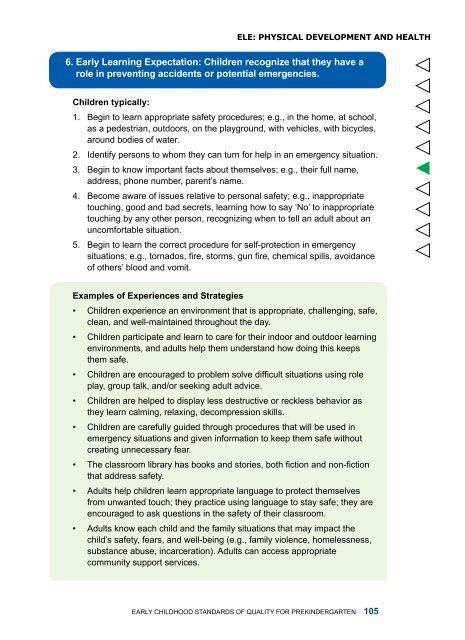Early Childhood Standards of Quality for ... - State of Michigan
Early Childhood Standards of Quality for ... - State of Michigan
Early Childhood Standards of Quality for ... - State of Michigan
Create successful ePaper yourself
Turn your PDF publications into a flip-book with our unique Google optimized e-Paper software.
ELE: Physical Development and Health6. <strong>Early</strong> Learning Expectation: Children recognize that they have arole in preventing accidents or potential emergencies.Children typically:1. Begin to learn appropriate safety procedures; e.g., in the home, at school,as a pedestrian, outdoors, on the playground, with vehicles, with bicycles,around bodies <strong>of</strong> water.2. Identify persons to whom they can turn <strong>for</strong> help in an emergency situation.3. Begin to know important facts about themselves; e.g., their full name,address, phone number, parent’s name.4. Become aware <strong>of</strong> issues relative to personal safety; e.g., inappropriatetouching, good and bad secrets, learning how to say ‘No’ to inappropriatetouching by any other person, recognizing when to tell an adult about anuncom<strong>for</strong>table situation.5. Begin to learn the correct procedure <strong>for</strong> self-protection in emergencysituations; e.g., tornados, fire, storms, gun fire, chemical spills, avoidance<strong>of</strong> others’ blood and vomit.Examples <strong>of</strong> Experiences and Strategies• Children experience an environment that is appropriate, challenging, safe,clean, and well-maintained throughout the day.• Children participate and learn to care <strong>for</strong> their indoor and outdoor learningenvironments, and adults help them understand how doing this keepsthem safe.• Children are encouraged to problem solve difficult situations using roleplay, group talk, and/or seeking adult advice.• Children are helped to display less destructive or reckless behavior asthey learn calming, relaxing, decompression skills.• Children are carefully guided through procedures that will be used inemergency situations and given in<strong>for</strong>mation to keep them safe withoutcreating unnecessary fear.• The classroom library has books and stories, both fiction and non-fictionthat address safety.• Adults help children learn appropriate language to protect themselvesfrom unwanted touch; they practice using language to stay safe; they areencouraged to ask questions in the safety <strong>of</strong> their classroom.• Adults know each child and the family situations that may impact thechild’s safety, fears, and well-being (e.g., family violence, homelessness,substance abuse, incarceration). Adults can access appropriatecommunity support services.<strong>Early</strong> <strong>Childhood</strong> <strong>Standards</strong> <strong>of</strong> <strong>Quality</strong> <strong>for</strong> Prekindergarten 105


